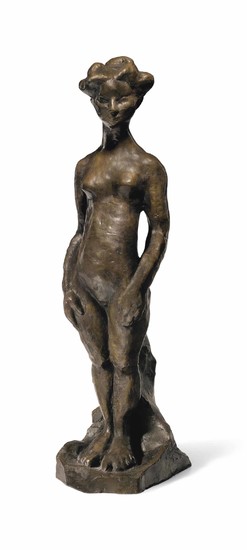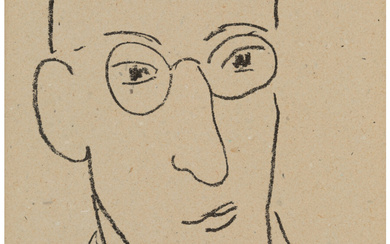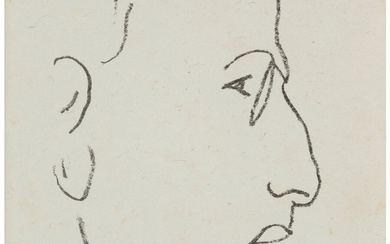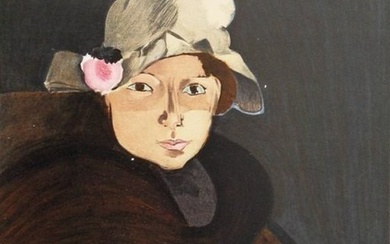Henri Matisse (1869-1954), Fillette debout, bras le long du corps
Henri Matisse (1869-1954)
Fillette debout, bras le long du corps
signed and numbered 'Henri Matisse 1/10' (on the lower right side); inscribed with foundry mark 'A. Bingen. Costenoble Fondeurs. Paris.' (on the lower left side)
bronze with brown patina
Height: 19 in. (48.3 cm.)
Conceived in Collioure, 1906 and cast circa 1908
Provenance
Oskar and Greta Moll, Berlin, Germany and Brieg, Poland (possibly acquired from the artist and until circa January 1945 when it was buried in their garden in Poland upon flight from the approaching Red Army).
Private collection.
Madura, Warsaw (possibly Andrzej Madura).
Roland, Browse & Delbanco Gallery, London (acquired from the above, December 1971).
Feingarten Galleries, Los Angeles (acquired from the above).
Harry W. and Mary Margaret Anderson (acquired from the above, June 1972).
Restituted to the heirs of Oskar and Greta Moll, 2016.
EUROPEAN SCULPTURE FROM THE HARRY W. & MARY MARGARET ANDERSON COLLECTION
The Anderson Collection stands as one of America?s most legendary assemblages of Post-War and Contemporary art, a peerless collection demonstrating over half a century of scholarship and dedication by Harry "Hunk" and Mary "Moo" Anderson. Inspired by a single visit to the Louvre Museum in the 1960s, the collection has come to encompass the very best in creative expression, providing a stimulating intellectual outlet for not just the Anderson family, but the countless students, scholars, and museum-goers who have benefitted from the Andersons? profound generosity.
Passionate and genuine, the Andersons have always valued the growth and vitality of their collection above any desire for renown or celebrity. ?[The Andersons?] lack of formality,? writes Hilarie M. Sheets, ?is just part of the disarming charm that has won the couple close relationships with artists, dealers and academics.? Hunk Anderson put it his own way: ?Big ?A? for art, little ?a? for Anderson.? Yet in building one of the world?s finest collections of American art, the couple have solidified their place as connoisseurs of the highest caliber, living a self-described ?journey to the new? that continues to this day.
A COLLECTION?S GENESIS
The extraordinary collection for which the Andersons are celebrated was, in truth, born by chance, during a fortuitous 1964 trip to Europe. In Paris, what was meant to be a half-day visit to the Louvre Museum became an unexpected two-day dialogue with fine art. ?Something came over us in the Louvre,? Hunk Anderson later recalled. ?We felt for the first time the beauty and excitement of the world of art and had to be a part of it.?
Upon their return from Paris, the Andersons discussed putting together a collection of world-class art. They agreed to acquire a few Impressionist and Post-Impressionist works. Among their first purchases were pictures by Monet, Pissarro, Renoir, Picasso, and others. As ?the best of the best? was already held in museums, the couple shifted their focus to the Early Modernists, German Expressionists, and Early American Modernists, obtaining pictures by artists such as Hartley, Luks, Rodin, O?Keeffe, Prendergast, and Sargent. It was not until Moo Anderson took another trip?this time to New York, in 1968?that the couple?s collection began to turn in a particular direction. With Mrs. Anderson?s New York purchase of Diebenkorn?s bound portfolio 41 Etchings, Drypoints, the couple?s fascination with American Contemporary art solidified.
FOCUS ON THE BEST
In turning to the art of their own time, Hunk and Moo Anderson found a wealth of groundbreaking, informed work, often by living artists.
The collectors sought out the best examples in periods and styles including Abstract Expressionism, Color Field Painting, Post-Minimalism, Pop, Bay Area Figurative art, and Contemporary abstract painting. In addition to leading artists such as Rothko, Gottlieb, Still, Pollock, Frankenthaler, and de Kooning, the Andersons acquired the work of California figures such as David Park, Jay DeFeo, Wayne Thiebaud, and Nathan Oliveira. ?Balancing New York School artists with their West Coast contemporaries,? Sheets writes, ?appealed to the Andersons as it reflected their own move from New York.?
The Andersons believed that art should be a family affair, and their daughter Mary Patricia?affectionately known as "Putter"?grew up surrounded by the best in Contemporary art and culture. After art historian Barbara Rose visited the family?s home, she was stunned to find that ?each room had a masterpiece in it.... Nothing in the house was meant to distract from the art, and each work was treated with the kind of respect that serious art deserves.?
INSPIRING GENEROSITY
Like other great collectors, Hunk and Moo Anderson strongly believe that they are merely ?custodians? of a body of work that belongs to the world. To this end, they have devoted their efforts to showcasing the collection via private tours of their home, as well as through extraordinary bequests to museums and cultural institutions. As Moo Anderson has stated, ?To enjoy art, I feel you must share it.? In 2011, the Andersons made headlines when they donated some 121 masterworks?anchored in the work of the New York School?to Stanford University. It is one of the most significant donations of fine art in American history, with star names such as Pollock, Rothko, Still, Kline, Thiebaud, Diebenkorn, Frankenthaler, and Celmins represented in a new permanent building housing the Anderson Collection. ?It?s good to study art in books,? Hunk Anderson said of the Stanford bequest, ?but something happens in the presence of the original?it affects the brain, taste, feelings, and more.?
While the Stanford bequest has spurred the Andersons to see their home in a new way, the collectors have in more recent years embraced the work of younger, emerging artists. Unflagging in their dedication to cultural patronage, the Andersons? charitable foundation also supports the visual arts in the Bay Area and the Western United States through its collection-sharing program, and provides support services to enhance creative initiatives across the nation. ?It keeps us motivated,? Hunk Anderson said of the bequests. ?It keeps us interested. It?s one of our hopes and desires that this is going to do the same for other people who are going to be able to see this collection.... I think it has had a direct influence over our relationships, as well as our longevity.?
The depth and quality of the Anderson Collection is a testament to not only Hunk and Moo Anderson?s curatorial vision, but to the power of art in changing lives. A visit to the Louvre sparked an unexpected and heartfelt journey in collecting, the results of which are still celebrated across the United States and beyond. ?Each painting has been an event in our lives,? Hunk Anderson remembered, ?and luckily they?ve always been happy events.? Indeed, the spirit and joy of Hunk and Moo Anderson lives on in each work within the Anderson Collection, a tangible legacy that continues to inspire.
EUROPEAN SCULPTURE FROM THE HARRY W. & MARY MARGARET ANDERSON COLLECTION
View it on
Sale price
Estimate
Time, Location
Auction House
Henri Matisse (1869-1954)
Fillette debout, bras le long du corps
signed and numbered 'Henri Matisse 1/10' (on the lower right side); inscribed with foundry mark 'A. Bingen. Costenoble Fondeurs. Paris.' (on the lower left side)
bronze with brown patina
Height: 19 in. (48.3 cm.)
Conceived in Collioure, 1906 and cast circa 1908
Provenance
Oskar and Greta Moll, Berlin, Germany and Brieg, Poland (possibly acquired from the artist and until circa January 1945 when it was buried in their garden in Poland upon flight from the approaching Red Army).
Private collection.
Madura, Warsaw (possibly Andrzej Madura).
Roland, Browse & Delbanco Gallery, London (acquired from the above, December 1971).
Feingarten Galleries, Los Angeles (acquired from the above).
Harry W. and Mary Margaret Anderson (acquired from the above, June 1972).
Restituted to the heirs of Oskar and Greta Moll, 2016.
EUROPEAN SCULPTURE FROM THE HARRY W. & MARY MARGARET ANDERSON COLLECTION
The Anderson Collection stands as one of America?s most legendary assemblages of Post-War and Contemporary art, a peerless collection demonstrating over half a century of scholarship and dedication by Harry "Hunk" and Mary "Moo" Anderson. Inspired by a single visit to the Louvre Museum in the 1960s, the collection has come to encompass the very best in creative expression, providing a stimulating intellectual outlet for not just the Anderson family, but the countless students, scholars, and museum-goers who have benefitted from the Andersons? profound generosity.
Passionate and genuine, the Andersons have always valued the growth and vitality of their collection above any desire for renown or celebrity. ?[The Andersons?] lack of formality,? writes Hilarie M. Sheets, ?is just part of the disarming charm that has won the couple close relationships with artists, dealers and academics.? Hunk Anderson put it his own way: ?Big ?A? for art, little ?a? for Anderson.? Yet in building one of the world?s finest collections of American art, the couple have solidified their place as connoisseurs of the highest caliber, living a self-described ?journey to the new? that continues to this day.
A COLLECTION?S GENESIS
The extraordinary collection for which the Andersons are celebrated was, in truth, born by chance, during a fortuitous 1964 trip to Europe. In Paris, what was meant to be a half-day visit to the Louvre Museum became an unexpected two-day dialogue with fine art. ?Something came over us in the Louvre,? Hunk Anderson later recalled. ?We felt for the first time the beauty and excitement of the world of art and had to be a part of it.?
Upon their return from Paris, the Andersons discussed putting together a collection of world-class art. They agreed to acquire a few Impressionist and Post-Impressionist works. Among their first purchases were pictures by Monet, Pissarro, Renoir, Picasso, and others. As ?the best of the best? was already held in museums, the couple shifted their focus to the Early Modernists, German Expressionists, and Early American Modernists, obtaining pictures by artists such as Hartley, Luks, Rodin, O?Keeffe, Prendergast, and Sargent. It was not until Moo Anderson took another trip?this time to New York, in 1968?that the couple?s collection began to turn in a particular direction. With Mrs. Anderson?s New York purchase of Diebenkorn?s bound portfolio 41 Etchings, Drypoints, the couple?s fascination with American Contemporary art solidified.
FOCUS ON THE BEST
In turning to the art of their own time, Hunk and Moo Anderson found a wealth of groundbreaking, informed work, often by living artists.
The collectors sought out the best examples in periods and styles including Abstract Expressionism, Color Field Painting, Post-Minimalism, Pop, Bay Area Figurative art, and Contemporary abstract painting. In addition to leading artists such as Rothko, Gottlieb, Still, Pollock, Frankenthaler, and de Kooning, the Andersons acquired the work of California figures such as David Park, Jay DeFeo, Wayne Thiebaud, and Nathan Oliveira. ?Balancing New York School artists with their West Coast contemporaries,? Sheets writes, ?appealed to the Andersons as it reflected their own move from New York.?
The Andersons believed that art should be a family affair, and their daughter Mary Patricia?affectionately known as "Putter"?grew up surrounded by the best in Contemporary art and culture. After art historian Barbara Rose visited the family?s home, she was stunned to find that ?each room had a masterpiece in it.... Nothing in the house was meant to distract from the art, and each work was treated with the kind of respect that serious art deserves.?
INSPIRING GENEROSITY
Like other great collectors, Hunk and Moo Anderson strongly believe that they are merely ?custodians? of a body of work that belongs to the world. To this end, they have devoted their efforts to showcasing the collection via private tours of their home, as well as through extraordinary bequests to museums and cultural institutions. As Moo Anderson has stated, ?To enjoy art, I feel you must share it.? In 2011, the Andersons made headlines when they donated some 121 masterworks?anchored in the work of the New York School?to Stanford University. It is one of the most significant donations of fine art in American history, with star names such as Pollock, Rothko, Still, Kline, Thiebaud, Diebenkorn, Frankenthaler, and Celmins represented in a new permanent building housing the Anderson Collection. ?It?s good to study art in books,? Hunk Anderson said of the Stanford bequest, ?but something happens in the presence of the original?it affects the brain, taste, feelings, and more.?
While the Stanford bequest has spurred the Andersons to see their home in a new way, the collectors have in more recent years embraced the work of younger, emerging artists. Unflagging in their dedication to cultural patronage, the Andersons? charitable foundation also supports the visual arts in the Bay Area and the Western United States through its collection-sharing program, and provides support services to enhance creative initiatives across the nation. ?It keeps us motivated,? Hunk Anderson said of the bequests. ?It keeps us interested. It?s one of our hopes and desires that this is going to do the same for other people who are going to be able to see this collection.... I think it has had a direct influence over our relationships, as well as our longevity.?
The depth and quality of the Anderson Collection is a testament to not only Hunk and Moo Anderson?s curatorial vision, but to the power of art in changing lives. A visit to the Louvre sparked an unexpected and heartfelt journey in collecting, the results of which are still celebrated across the United States and beyond. ?Each painting has been an event in our lives,? Hunk Anderson remembered, ?and luckily they?ve always been happy events.? Indeed, the spirit and joy of Hunk and Moo Anderson lives on in each work within the Anderson Collection, a tangible legacy that continues to inspire.
EUROPEAN SCULPTURE FROM THE HARRY W. & MARY MARGARET ANDERSON COLLECTION







